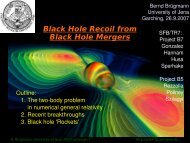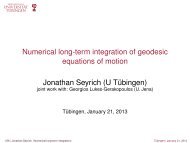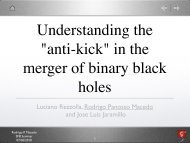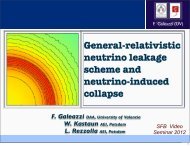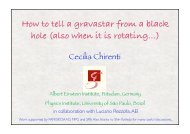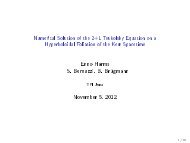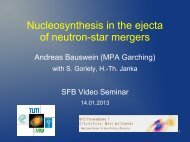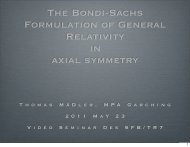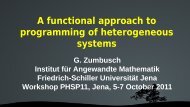Magnetized Binary Neutron Stars with Whisky
Magnetized Binary Neutron Stars with Whisky
Magnetized Binary Neutron Stars with Whisky
Create successful ePaper yourself
Turn your PDF publications into a flip-book with our unique Google optimized e-Paper software.
<strong>Magnetized</strong> <strong>Binary</strong><strong>Neutron</strong> <strong>Stars</strong> <strong>with</strong><strong>Whisky</strong>Bruno Giacomazzo(AEI, Potsdam, Germany)in collaboration <strong>with</strong>Luca Baiotti (Tokyo) and Luciano Rezzolla (AEI)
Plan of the Talk• Introduction• The <strong>Whisky</strong>(MHD) code• <strong>Binary</strong> <strong>Neutron</strong> Star Mergers• The Role of Magnetic Fields in the gws• Magnetic Fields amplification• Summary and Conclusions
Due to their duration anddynamics, <strong>Binary</strong> <strong>Neutron</strong> <strong>Stars</strong>are very good sources forgravitational wave detectors suchas Virgo (Italy) and Ligo (USA)Virgo (Pisa, Italy)<strong>Binary</strong> neutron stars mergers arealso possible sources for shortgamma-ray bursts
The <strong>Whisky</strong>(MHD) code• Full GR Magneto-Hydro-Dynamical Code– Based on the Cactus framework– Solves the HD and MHD equations on dynamical curvedbackground– Uses HRSC (High Resolution Shock Capturing) methods– Can handle BH formation <strong>with</strong> or <strong>with</strong>out Excision– Implements the Method of Lines– Adopts Adaptive Mesh Refinement techniques (Carpet)– Implements the Constrained Transport and theHyperbolic Divergence Cleaning schemes• It’s meant as an “astrophysical laboratory” tostudy several different sources of gws
Matter fields evolutionThe evolution equations of the matter are given as usual bythe conservation of the baryon number and energymomentum:∇ µ T µν = 0∇ µ J µ = 0J µ ≡ ρu µT µν = (ρ + ρɛ + p + b 2 )u µ u ν +plus an Equation of State P=P(ρ,ε)For the simulations presented here we have used duringthe evolution an ideal-fluid EoS P = ρɛ(Γ − 1) or apolytropic EoSP = κρ Γ(p + 1 )2 b2 g µν − b µ b ν
GRMHD equationsThe evolution of the magnetic field obeys Maxwell’s equations:∇ ν ∗ F µν = 0that give the divergence free condition:( ) √γ∇ · B ⃗ = 0and the equations for the evolution of the magnetic field:∂∂t( √γ⃗ B)= ∇ ×[(α⃗v − β ⃗ )×( √γ⃗ B)]
<strong>Binary</strong> <strong>Neutron</strong> <strong>Stars</strong> Mergers<strong>with</strong> Magnetic Fields
Previous WorksIn Newtonian Physics (SPH)•Price and Rosswog 2006, SCIENCE 312, 719•studied the mf amplification after the merger•initial mf B~10 12 GaussFully General Relativistic Simulations:•Anderson et al., PRL 100, 191101 (2008)•adaptive mesh refinement used•initial data built by hand•not able to follow the BH formation•initial mf B~10 16 Gauss (strong effects in the waves)•Liu et al 2008, PRD 78, 024012•no mesh refinement (“fish-eye” coords)•consistent (irrotational) initial data•only one orbit but follow the BH formation•second order reconstruction and low resolution•initial mf B~10 16 Gauss (weak effects in the waves)
Initial ModelAll the initial models are computed using the Lorene code forunmagnetized binary NSs (Bonazzola et al. 1999):Model M1,M2 d (km)low-mass 1.4 45high-mass 1.6 45Technical data for the simulations:• polytropic or ideal fluid EOS• outer boundary: ~370 km• 5 refinement levels; res. on finest level: ~0.36km• minmod or PPM for the reconstruction• HLLE flux• Runge Kutta (3rd-order)
Adding Magnetic FieldsWe have considered the same models also when an initiallypoloidal magnetic field of ~10 12 or ~10 17 Gauss is introducedThe magnetic field is added by hand using the following vectorpotential:A φ = A b r 2 [max(P − P cut , 0)] nA b P cut = 0.04 × max(P )where and are two constants definingrespectively the strength and the extension of the mf insidethe star. n=2 defines the profile of the initial mf.The initial magnetic field is contained inside the star
Starting Up...We started usingHLLE+minmod(2nd order) and aPolytropic EOSHere we considerthe high-massmodel <strong>with</strong>B~10 12 Gauss
Starting Up...We started usingHLLE+minmod(2nd order) and aPolytropic EOSHere we considerthe high-massmodel <strong>with</strong>B~10 12 Gauss
WaveformsWaveforms obtained using HLLE+minmod and a Polytropic EOS
WaveformsWaveforms obtained using HLLE+minmod and a Polytropic EOSHigh-mass
WaveformsWaveforms obtained using HLLE+minmod and a Polytropic EOSLow-massHigh-mass
WaveformsWaveforms obtained using HLLE+minmod and an Ideal FLuid EOS
WaveformsWaveforms obtained using HLLE+minmod and an Ideal FLuid EOSNo differences in the waves even for large magnetic fields !?!
WaveformsMinmod is known to be dissipative.We moved to HLLE+PPM (3 rd order)Here weconsiderthe highmassmodel<strong>with</strong> B=0and B~10 17Gauss andan IdealFluid EOS
WaveformsMinmod is known to be dissipative.We moved to HLLE+PPM (3 rd order)Here weconsiderthe highmassmodel<strong>with</strong> B=0and B~10 17Gauss andan IdealFluid EOSStrong differences in the waves also during the inspiral!!!
MHD effects during the inspiralHere we consider the high-mass model <strong>with</strong> B=0 and B~10 17 Gaussand a Ideal Fluid EOS evolved <strong>with</strong> HLLE+PPM (3rd order)high-mass IF B=0 high-mass IF B~10 17
MHD effects during the inspiralHere we consider the high-mass model <strong>with</strong> B=0 and B~10 17 Gaussand a Ideal Fluid EOS evolved <strong>with</strong> HLLE+PPM (3rd order)high-mass IF B=0 high-mass IF B~10 17
MHD effects during the inspiralHigh-mass model <strong>with</strong> B=0 and B~10 17 Gauss and Ideal Fluid EOS~1.5 ms ofdifference in thetime of the merger
MHD effects during the inspiralhigh-mass IF B=0 high-mass IF B~10 17 The mf hasan effect onthe tidaldeformationsand then onthe inspiral
Magnetic field amplificationHigh-mass model <strong>with</strong> B~10 17 Gauss and an Ideal Fluid EOSAfter the mergerthe magnetic field isamplified of oneorder of magnitude
Hydrodynamics InstabilitiesDuring the merger a shear interface forms acrosswhich the velocities are discontinuous.This leads to the formation of vortices (Kelvin-Helmholtz instability).In the presence of a poloidal magnetic field, thisdetermines the generation of a large toroidal magneticfield even if the poloidal one is smallThis can have an important role in the formation ofmagnetars and short gamma-ray bursts
KH instability: high-mass BNSVisualization by Giacomazzo, Rezzolla
KH instability: high-mass BNSVisualization by Giacomazzo, Rezzolla
KH instability: high-mass binaryNote the development of vortices inthe shear boundary layer producedat the time of the mergerMore evident in terms of theweighted vorticity.in “corotating” frame
KH instability: high-mass binaryEvolution ofthe weightedvorticity forhigh-massideal-fluid<strong>with</strong>out mf
KH instability: high-mass binaryEvolution ofthe weightedvorticity forhigh-massideal-fluid<strong>with</strong>out mf
Conclusions•We were able to perform the inspiral and merger of BNSs <strong>with</strong>different magnetic fields since some time; we now believe theresults are robust•Crucial to use high-order reconstruction (at least 3rd order)•Effects of high-magnetic fields are clearly visible in the gwsboth during the inspiral and after the merger•We are able to extract the full gravitational wave signal•We are extending the picture to include a larger set ofpossible magnetic field strengths•the amplification of the magnetic field at the merger and afterBH formation is particularly challenging; great care is needed toobtain convincing results




